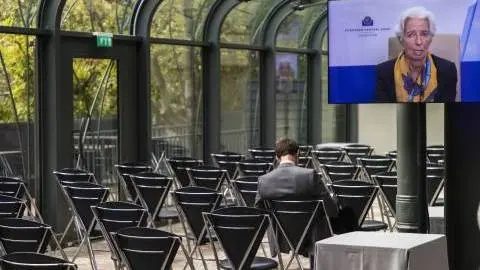ECB: Preparing for the second wave
More infections, more restrictions and more monetary easing? Next week, the ECB could pave the way for more stimulus in December without showing its cards. And we think the likelihood of increasing the PSPP envelope are more than increasing the PEPP programme
The last few weeks since the September ECB meeting have been marked by a wave of speeches, blog entries and communication.
After the slightly confusing press conference in September, the ECB has obviously tried to be more present and getting the power of word back but it is still hard to read the ECB under its not so new president Christine Lagarde. In the Draghi-era it was very clear that it was mainly Mario Draghi and Peter Praet, ECB watchers had to listen to in order to get a picture of the future path of the ECB. But now, it challenging to tell who really is calling the shots.
Having said that, at next week's ECB meeting, we think Christine Lagarde could take the lead and pave the way for fresh stimulus in December.
The old rift opens again
After the September meeting, it seemed as if the old rift between hawks and doves had re-surfaced.
While the doves are on high alert, and warn against any complacency and argue in favour of doing more in case of more deflationary forces, the hawks seem to argue that any deflationary pressures are the result of several one-off factors and should disappear in 2021. Also, the adverse effects of more monetary stimulus don't justify further easing.
Recent economic developments seem to support the doves. The plateauing of activity started in September but new lockdown measures and social distancing rules will in our view clearly dampen activity in the fourth quarter. Currently, these measures look like ‘smart’ or ‘recreational’ lockdowns with most restrictions taking place in the service and leisure sector but new lockdowns similar to the ones in Spring can no longer be excluded.
So, even if the new restrictions mainly impact local or domestic economies for now and not supply chains or spill-over to other countries, but if all eurozone countries eventually apply the same measures, the result will be the same: a double-dip in the eurozone.
Risk of a double-dip has increased
Even if the risk of a double-dip has clearly increased, it is in our view still too early to call a significant contraction of the eurozone economy in the fourth quarter.
Manufacturing, partly because it started the rebound later than services but partly also due to the strong rebound in China, could still continue its catching up into the fourth quarter. Thereby, at least partly offsetting the negative impact from ‘smart’ lockdowns. In any case, double-dip or not, the ECB’s September projection of GDP growth by 3.1% QoQ in Q4 looks way too optimistic.
In any case, double-dip or not, the ECB’s September projection of GDP growth by 3.1% QoQ in Q4 looks way too optimistic
Also, the fact that currently as many goods in the consumer price basket show falling prices as in 2014 suggests that there is more to the deflationary threat story than lower energy prices and a German VAT reduction. And the stronger euro is not helping either. In this regards, the ECB released an interesting working paper this paper, suggesting that QE could be the first line of defence if the ECB was to tackle the stronger euro.
All in all, the case of more easing is building up quickly.
What we expect next week
After the monetary policy, the discussion about what the ECB could do to tackle climate change and support European initiatives has heated up in recent weeks. There are several options possible, for example, using the collateral framework or asset purchases to support the shift towards a greener eurozone economy.
We think the ECB is likely to increase the PSPP envelope in December, rather than increase the PEPP programme
At the same time, the ECB has the option to use its role as bank supervisor to steer this shift. However, as with the discussion about any changes to the definition of price stability and the ECB’s strategy review, we think the ECB is unlikely to announce any major changes before the strategy has been concluded, which will not be before mid-2021.
For next week’s meeting, we don’t expect the ECB to show its cards. The controversies within the Governing Council on what to do next are still quite strong. However, recent economic developments have clearly strengthened the case for the doves.
We anticipate an increase in the PSPP envelope in December, rather than an increase in the PEPP. Christine Lagarde could definitely present some hints. Even if some might argue that recent months have shown that the real communication action is no longer taking place at the press conference but in the blog entry the day after.
We will be monitoring both. Very closely.
This publication has been prepared by ING solely for information purposes irrespective of a particular user's means, financial situation or investment objectives. The information does not constitute investment recommendation, and nor is it investment, legal or tax advice or an offer or solicitation to purchase or sell any financial instrument. Read more
Download
Download article
22 October 2020
Second wave, second chance? This bundle contains 7 Articles